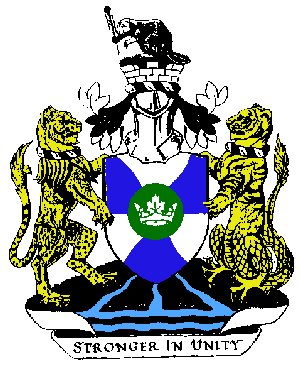
One of the most criticized features of the first proposed design for the new Toronto arms was the moster supporters. For my part, I think the criticism was justified and should cause the Heraldic Authority to do some serious thinking.
Certain mosters have figured in heraldry for centuries, but the earliest all came out of the mediaeval bestiaries and were believed to be real animals. Unicorns' horns and griffins' talons (actually narwhal and ibix horns- respectively) could be seen on display in the castles and manor houses of mediaeval and Tudor England. These mythical beasts are now woven into our art and literature and make up a significant part of our cultural heritage, and no lover of heraldry would want to banish them from the heraldic zoo.
Even the Lancaster and Stafford antelope and the Bedford and Beaufort yale, which had appeared by 1450, probably represented real animals, the elk and mountian goat respectively. But they seem to have set a fashion for exotic beast badges, and by the end of the century the heralds were meeting the demand by deliberately making up new fabulous animals out of the "spare parts" of real ones. Hence the Warr alfin, Sir Thomas Burgh's borain, and the like. The give modern heralds a clear precedent for creating new monsters, but is it a good precedent? Some of them (such as the tragopan)

Tragopan |
The Renaissance brought other hybrids into heraldry, mostly taken [from] classical mythology. Some of these have proved [sic] their worth. Pegasus, for instance, is clearly apt for the arms of poets or modern bodies involved in aviation. My feeling, however, is that there are limits to how far heralds should go in introducing new fabulous creatures, and if one cannot formulate rules, one can at least state some principles. Those who consult Heraldry and The Art of Heraldry, both by present Garter King of Arms Peter Gwynn-Jones, will find most of my examples there and can judge my suggestions for themselves.
First, traditional fabulous animals from other cultures seem to work where the grantee has some appropriate link with the tradition on which the granting authority draws. One feels delight in finding a Chinese dragon as a supporter in the arms of the former Crown Colony of Hong Kong, or two chi lin (Chinese unicorns) bearing up those of its Chinese university.
Second, new borrowings from classical mythology, romance, or the bestiaries work best when they have a clearly appropriate symbolism. As birds able to cure disease, two caladrii are an eminently suitable crest for the Isle of Wight Health Authority, and one wonders why no air vice-marshal or fighter ace has ever received a hippogriff. On the other hand, the catoblepas, whose gaze

Catoblepas |
Lastly, sometimes a new fabulous creature is obviously right. In an age when people travel by air as often as by sea, winged sea unicorns are clearly apt supporters for the U.K. Overseas League. But most modern inventions seem merely silly. The college of Arms has developed a particlularly annoying penchant for sticking gratuitous wings on supporters. Lynxes are traditionally famed for their keen sight, which made them excellent supporters for the arms of the British College of Opthamologists. But what was gained by giving those lynxes wings, except to provide more material for compilers of books on heraldic curiousities? Or how is a winged sea-bull appropriate to the Queensland State Chamber of Commerce and Industry?
Bearing these examples in mind, let us look again at the supporters in the original proposal for the new Toronto arms. In dexter we had the top half of a lion - and, apparently, the end of the tail - joined to the bottom half of an ocelot; in sinister, the same combination of a bengal tiger and a dragon.

|
The proposed supporters were monsters not only in the OED sense 3, "an imaginary animal... compounded of elements from two or more animal forms" but also in sense 2 "a misshaped birth: an abortion." Heraldry is an eminently traditional art, and Rodney Dennys laid down a sound principle when he wrote that "New chimerical creatures should only be evolved if there is nothing in our stables which will fit, and they should be apt and have a reasonably plausible pedigree" (The Heraldic Imagination, p. 51). When the herald goes to the sources of the tradition and comes back with what is just right - as with the Wight caladrii - or when he successfully assimilates exotic traditions into the system - as in the Hong Kong examples cited above - he shows his art is alive and well. But inventing ungainly and unintelligible new monsters is as much a symptom of heraldic decadence in the second Elizabethan age as it was in the first. We do not need such things when we have so many traditional creatures of proven worth to choose from, both real and fanciful. If we want greater variety, we should do better [to] follow the example of recent grants from Australia and make more use of the real fauna of our own country, as is done in the design the Toronto City Council ultimately approved. The reception given to the first-proposed Toronto supportters, both by City Council and in the press, should serve as a warning. Introducing monsters of that kind only makes our noble and ancient science look silly in the public eye, and deservedly so.
By William Cooke, with drawings by Bruce Patterson. Typos are the fautl of the webmaster. Opinions put forth here are those of the author, and not necessarily those of the Heraldry Society of Canada, the Toronto Branch thereof, or of the webmaster.
Back to the Hogtown Heraldry Index
Back to the Toronto Branch website
Inquiries regarding these pages should be sent to The Mad Alchemist (webmaster).
© The Heraldry Society of Canada, Toronto Branch 1999. Web version © The Mad Alchemist 2001